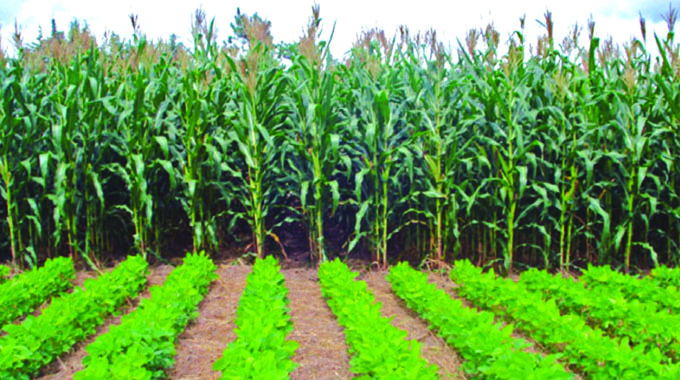Conservation farming future of agriculture

Irene Kalulu
Correspondent
Women are the heart of most farming activities in the country, they do most of the work.
Having seen the erratic weather patterns and the reduction in yields caused by climate change, a few women from Zhombe district have opted out of using conventional farming methods.
They have embraced conservation agriculture, some having been practising it for over 10 years now.
Conservation agriculture or farming is a concept for resource-saving agricultural crop production that conserves the environment.
Farmers use different measures like no tilling, no fertilisers or pesticides, but use organic means which do not damage the environment.
The country has been experiencing frequent and severe droughts, storms, high temperatures and overall conditions unfavourable for living and farming.
Zimbabwe is predominantly dependent on farming for its food supply needs, therefore agriculture remains the answer to the country’s problems.
The Government has been encouraging conservation farming, giving inputs like seeds, technical support, fertilisers to those who are taking part in the government led “Pfumvudza” project.
The Pfumvudza project is a government- led input programme, a conservation farming technique meant to drive Zimbabwe towards food sustenance.
This, in an effort to meet the United Nations’ (UN) Sustainable Development Goals (SDGs), SDG 2 on ending hunger, achieving food security and improving nutrition.
For Norita Phiri (72), conservation farming has been a blessing for her and her family for the past nine years.
When her husband died, they only had two cows. She had to sell one to cater for expenses during the course of her husband’s funeral, the other she lost during a drought season.
What she went through when her husband died, and that she had to look after her family on her own, drove her passion to learn more about conservation farming.
An organisation called Self Help Development Foundation (SHDF) came to her village to teach people best farming practices suitable for drought-ridden environments.
“Most people laughed at us when we started using boma sheets and not tilling our fields. They thought it was folly and would not amount to much in terms of harvesting. But I noticed that when we had a bad rainy season my field retained moisture because of the method we used of just having plant points where we put manure and our seeds,” she said.
The use of boma sheets in farming, is where farmers have moving cattle pens where cattle can graze in a particular field so that the cattle dung fertilises that particular field.
After two weeks they move the pen to another person’s field and rotate until every person’s field is rich in manure.
The introduction of grazing livestock to a field that once held crops is beneficial to the farmer and the field itself. Livestock manure can be used as a natural fertiliser for a farmer’s field.
Kwekwe District Crop and Livestock Officer Virginia Mare said that as a department they have also been going around the district teaching farmers adaptive strategies to combat climate change in farming.
“Farmers are doing conservation agriculture and they have been able to yield enough maize for household consumption and some left over to sell.
“This is evidenced by the price of a bucket of maize that has remained stable in most areas.
“Some have resorted to growing drought resistant small grains like cow peas which do well with little rain,” she said.
Women like Crescencia Chipangura (43), of Jinja Village in Zhombe have benefited from this programme after she started conservation farming in 2021.
For the first time in 10 years, she harvested four tonnes where she ordinarily would harvest two tonnes.
“I regret not having started this practice sooner, I saw others doing it but I always thought it was too time-consuming. But my harvest last season has motivated me to continue with conservation farming. As a family we have never experienced such a harvest,” she said.
Stubble mulching is another conservation method where you place the stubble or crop residue on the land as surface cover during a fallow period. Stubble mulching helps prevent erosion from wind and water and helps conserve the soil’s moisture.
Minimum soil disturbance is essential to maintaining minerals within the soil, stopping erosion and preventing water loss from occurring within the soil.
Tillage is seen as destroying organic matter that can be found within the soil cover.
Norita Phiri says that when she used conventional farming methods she would harvest less than a tonne of maize.
But when she perfected the art of conservation farming she started harvesting two tonnes of maize crop.
“I have been able to send all my children and grandchildren to school, not only that but I now own six cattle and have built a two-roomed house. Those around me who have refused to embrace these new farming practices are struggling because of the hot temperatures,” she said.
Anna Brazier, a Sustainable Development Consultant says that it is important for people to know how to protect soil from erosion and manage fertility using locally available materials.
“We have to protect the soil. Conventional methods of farming using ploughing, fertilisers and pesticides are causing untold harm to the environment. We have to do all we can to protect the soil,” she said.
Besides maize crop, Junior Manyatela (54) grows small grains which are more drought resistant.
“Everyone in my community can tell you how my life has changed. I always have food to eat in my home. When you practise conservation farming you are guaranteed a harvest. Your crops won’t die when the rainfall is erratic,” she said.










Comments